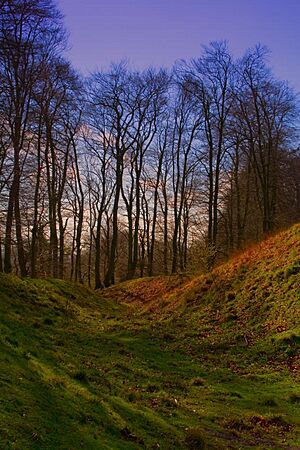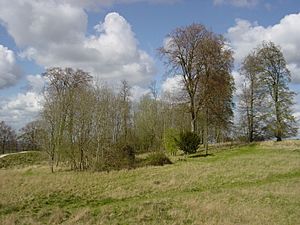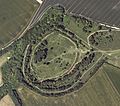Danebury facts for kids
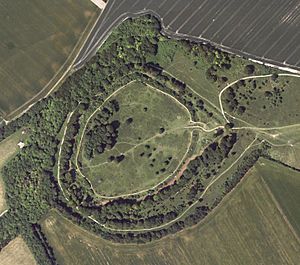
Aerial image of Danebury
|
|
| Location | Hampshire, England |
|---|---|
| Coordinates | 51°08′12″N 1°32′15″W / 51.136681°N 1.537569°W |
| Type | Hillfort |
| Area | 5 hectares (12 acres) |
| History | |
| Founded | c. 550 BC |
| Abandoned | c. 100 BC |
| Periods | Iron Age |
| Site notes | |
| Excavation dates | 1969 – 1988 |
| Public access | Yes |
| Danebury Hillfort | |
|---|---|
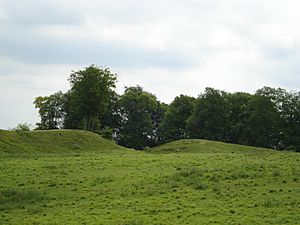
Entrance to the hill fort
|
|
| Type | Local Nature Reserve |
| Location | Nether Wallop, Hampshire |
| OS grid | SU 326 376 |
| Area | 39 hectares (96 acres) |
| Managed by | Hampshire Countryside Service |
Danebury is an amazing Iron Age hill fort located in Hampshire, England. It's about 19 kilometers (12 miles) north-west of Winchester. This ancient site covers about 5 hectares (12 acres).
Archaeologists led by Barry Cunliffe carefully dug up and studied Danebury in the 1970s. It's considered a very important example of a hill fort because it was explored so thoroughly. This helped experts learn a lot about how hill forts were built and used.
People lived at Danebury for almost 500 years, starting around 550 BC. During this time, many more hill forts were built in the Wessex area. Danebury was changed and improved many times, becoming a complex "developed" hill fort. Today, it's a protected Scheduled monument and a Local Nature Reserve called Danebury Hillfort. The area around it is also a Site of Special Scientific Interest.
Contents
Discovering Danebury's Secrets
For a long time, people didn't know much about hill forts. In the Middle Ages, folks thought famous figures like King Arthur or Alfred the Great built them. Some even believed giants were responsible! By the 1700s, many thought the Romans had built them.
Interest in hill forts grew in the early 1800s. The first dig at Danebury happened in November 1859. An expert named Augustus Wollaston Franks led workers who found a deep pit. They didn't know what it was for at the time.
Later in the 1800s, Augustus Pitt-Rivers studied many hill forts in Sussex. He figured out that most were built during the Iron Age. This discovery paved the way for future research. By 1940, about 80 hill forts in Britain had been dug up by archaeologists.
The Big Dig at Danebury
In the late 1960s, Barry Cunliffe decided to focus on one hill fort and its surroundings. He wanted to understand more about Iron Age society. With permission from the local council, excavations at Danebury began in 1969. They continued for 20 years until 1988!
During these digs, archaeologists explored the fort's defenses and entrance. They also dug up more than half of the inside of the fort. Here, they found traces of houses made from wattle and timber. This was the longest study of any hill fort in western Europe.
In 1997, another survey was done using a special tool called a magnetometer. This tool can detect things underground without digging.
Life at Danebury Hillfort
We don't have written records from the Iron Age in Britain. So, archaeologists learn about Danebury's past by studying what they find in the ground. It's hard to know every single event, but we can piece together a general timeline.
People lived at Danebury from around 550 BC until about 100 BC. The fort's defenses were changed and rebuilt many times over the years.
Building the Fort's Defenses
When Danebury was first built, it had a single ditch around an area of about 5 hectares (12 acres). There were two entrances, one in the south-west and one in the east. Later, two more rings of ditches were added.
Inside the fort, the northern part had structures with four posts. These were probably granaries for storing grain. Later, these were replaced by storage pits dug into the ground. In the southern part, there were roundhouses where people lived.
The first defenses were built around 550 BC. They included a rampart (a large bank of earth) behind a ditch. Workers used chalk and clay from the ditch to build the rampart. It was held in place by timber, making a strong, vertical wall. The eastern entrance was a simple 4-meter (13-foot) wide gap with a timber gatehouse.
About 50 years later, the rampart was made taller. This was likely to fix it as the timber started to rot. Around the same time, the eastern entrance was made wider, to 9 meters (30 feet). The gates were burned down shortly after this change. For a short time, the fort had no gates. When the eastern entrance was fixed, the path into the fort was made longer.
Around 400 BC, the rampart was made even higher, and the ditch was dug deeper. The new ditch was V-shaped, about 6 meters (20 feet) deep and 11 to 12 meters (36 to 39 feet) wide. The old wooden box structure was replaced. The rampart now sloped down to the ditch. It probably had a dry stone wall made of flint on top for extra protection. From the top of the rampart to the bottom of the ditch was about 16 meters (52 feet).
Changes Inside and Out
Even though the main rampart and ditch stayed the same for a long time, the eastern entrance was changed twice. It was made longer, with earthworks (banks of earth) on each side of the path. The south-west entrance also got extra defenses before it was closed off.
During this time, the southern part of the fort saw new four- and six-post structures, likely more granaries. The center of the fort might have been used for special shrines. Houses were mostly built near the ramparts.
New earthworks were also added outside the existing ring. This made Danebury a complex multivallate fort, meaning it had more than one set of defenses. These new earthworks added about 5.3 hectares (13 acres) to the fort. They were probably used to protect farm animals.
Why Was Danebury Important?
Danebury Hill is 143 meters (469 feet) high. The hill fort sits on top, looking over the whole area. The land around it has light soil, which was easy to farm. The people of Danebury had access to forests, pastures, and water from the River Test.
Other nearby hill forts, like Figsbury Ring and Quarley Hill, were probably built around the same time. They were all similar in size and spread out evenly, controlling similar areas and resources.
A Fort for Protection or Power?
Experts debate if hill forts were only for defense or if they had other uses. Barry Cunliffe believes the ramparts were mainly for protection. However, he also thinks they showed off the wealth and power of the people living there. Danebury could be seen for miles around!
The complex entrances show that the fort was designed for defense. The long, curving eastern entrance would slow down attackers. This gave defenders on the ramparts more time to throw things at them. The south-west entrance forced attackers into a narrow space, causing confusion.
Cunliffe believes Iron Age society was often "unstable, and prone to conflict." The military design of hill forts supports this idea. The burning of the gates was likely from an attack. At the end of Danebury's main use, about 100 bodies were found in pits. Many had injuries that looked like they came from weapons.
A Central Hub
Many smaller farms were located around Danebury hill fort. The fort received grain from these farms. It could store 20 times more food than an average farm. This suggests Danebury was a very important place. It was a "central place" where people could gather to trade and store goods.
Sometimes, hill forts like Danebury became more active while nearby farms became less populated. This might mean hill forts were becoming more important in society. Or, it could mean people moved to the safety of the fort during times of trouble.
While other hill forts were abandoned around 400 BC, Danebury grew into a "developed hill fort." Its importance increased over time. It was probably home to a leader or chieftain, their family, and skilled workers. It might have had a population of 200 to 350 people. There's evidence of a lot of crafting and industry. The presence of shrines in the center of the fort also suggests it was used by important people.
Danebury was finally abandoned around 100 BC. This was a common trend for hill forts across Britain at that time. The eastern gate was burned down again, but this time it wasn't replaced. Most people left Danebury. The buildings were left to fall apart, and the inside of the fort became a place for grazing animals. By the early 1st century AD, Danebury was probably just a single farm.
Images for kids



